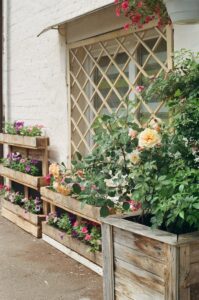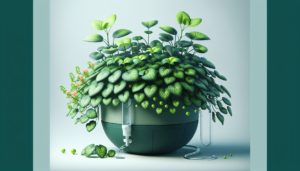Are you ready to embark on a journey of green thumbs and blooming beauty? We have the perfect beginner’s guide to gardening that will have you digging in the dirt in no time! From choosing the right plants for your space to mastering the art of watering and fertilizing, our guide will equip you with all the essential knowledge and tips to get your garden off to a flourishing start. So grab your gardening gloves and join us as we explore the wonderful planting world! Gardening is a fulfilling and rewarding hobby, allowing us to connect with nature and create a beautiful, vibrant outdoor space. Whether you have a spacious backyard or a small balcony, starting a garden is something anyone can do. However, knowing and understanding the basics is essential before diving in. This article will guide you through the critical steps to start planting and help you create your little slice of paradise.
Choosing the Right Location
Assessing sunlight
When selecting a location for your garden, it is crucial to consider the amount of sunlight the area receives. Most plants require at least six hours of direct sunlight to thrive, while some shade-loving varieties can tolerate partial shade. Observe the different areas of your space throughout the day to identify the spots with the most sun exposure. This will help you determine which plants will flourish in each region.
Consider soil quality
The quality of your soil plays a vital role in the success of your garden. Take some time to evaluate the soil in your chosen location. Is it sandy, clayey, or loamy? Sandy soil drains quickly, while clayey soil retains water. Loamy soil, a combination of sand, silt, and clay, is ideal for most plants as it offers good drainage and retains moisture. Add organic matter, such as compost or aged manure, to improve the soil structure and nutrient content.
Evaluate drainage
In addition to soil quality, assessing the drainage of your chosen location is essential. Poor drainage can lead to waterlogged soil, which can harm plant health. To determine your site’s drainage, dig a hole about one foot deep and fill it with water. If the water does not drain within a few hours, you may need to explore options to improve the drainage, such as creating raised beds or amending the soil with organic matter.
Selecting Plants
Determine climate suitability
Different plants have varying climate requirements, and choosing varieties suitable for your specific climate is crucial. Consider your area’s average temperature, rainfall, and frost dates. Consult local gardening resources, such as plant hardiness zone maps, to determine which plants will most likely thrive in your region. This will increase your chances of success and ensure that your plants are well-suited for the climate conditions they will experience.
Identify plant preferences
Just as humans have preferences, plants also have specific needs and preferences. Some plants prefer full sun, while others thrive in the shade. Some plants enjoy moist soil, while others prefer drier conditions. Take the time to research the specific preferences of the plants you wish to grow. This will help you create a harmonious garden where each plant can fulfill its full potential.
Consider garden size
The size of your garden will determine how many plants you can accommodate. Consider the space available and how much time and effort you will invest in maintaining your garden. Starting with a small garden plot allows you to focus your attention and ensure each plant receives the care it needs. As you gain experience and confidence, you can gradually expand your garden to include more plants and varieties.
Preparing the Soil
Remove weeds and debris.
Preparing your soil by removing any weeds, plants, or debris is essential before planting. Weeds can compete with your plants for nutrients and space and should be removed to create a clean canvas for your garden. Use a garden fork or trowel to lift and remove unwanted plants gently. Clearing the area of debris ensures that nothing interferes with the growth and development of your plants.
Test soil pH
Testing your soil’s pH level is crucial as it determines the availability of nutrients to your plants. Most plants prefer a slightly acidic to neutral pH, around 6.0 to 7.0. You can easily find soil testing kits at garden centers or have your soil tested by a professional or cooperative extension service. Based on the results, you can make adjustments by adding materials such as lime to raise the pH or sulfur to lower it.
Add organic matter
Adding organic matter to your soil is an excellent way to improve its structure and fertility. Organic matter, such as compost or aged manure, enriches the soil with essential nutrients and helps retain moisture. Spread a layer of organic matter over the topsoil and gently mix it using a garden fork or shovel. This will ensure that the nutrients are distributed evenly and readily available to your plants.
Start Small
Begin with a small plot.
If you are new to gardening, it is advisable to start small. A small garden plot lets you focus your efforts and learn the basics without feeling overwhelmed. As you gain experience and confidence, you can gradually expand your garden to accommodate more plants and experiment with different varieties.
Limit the number of plants.
When starting, filling your garden with a wide array of plants can be tempting. However, it is essential to resist the urge to overcrowd your space. Inexperienced gardeners may quickly become overwhelmed with the maintenance and care required for numerous plants. Instead, choose a select few plants you are most excited to grow and dedicate your attention to their success.
Focus on easy-to-grow varieties.
Focus on growing easy-to-grow plant varieties to increase your chances of success and build confidence in your gardening abilities. These plants are often more forgiving of beginner mistakes and more likely to thrive with minimal intervention. Some popular easy-to-grow plants include tomatoes, zucchini, marigolds, and sunflowers. Once you become comfortable with these varieties, you can experiment with more challenging plants.
Planting Techniques
Digging holes of appropriate size
When planting, it is crucial to dig holes appropriate in depth and width for the size of the plant roots. The hole should be wide enough to comfortably fit the root ball and deep enough so the plant is at the same level as in its container. Avoid digging too deep, as this can accumulate water around the roots.
Loosening the root ball
Before placing the plant into the hole, gently loosen the root ball to encourage growth. Gently massage the roots with your hands or use a gardening tool to separate any tangled or circling roots carefully. This allows the roots to spread outwards and establish themselves more effectively in the new soil.
Watering newly planted seedlings
Watering newly planted seedlings is crucial to help them establish themselves in their new environment. After planting, water the seedlings thoroughly to ensure the soil is moistened to the root level. This will encourage the roots to grow, preventing the plant from becoming stressed or dehydrated.
Mulching the soil
Mulching the soil is an effective technique to conserve moisture, suppress weeds, and regulate soil temperature. After planting, apply a layer of organic mulch, such as straw, wood chips, or dried leaves, around the base of your plants. This will help retain moisture in the soil, reduce weed growth, and provide insulation for the roots during temperature fluctuations.
Watering Strategies
Understanding plant water requirements
Understanding your plants’ water requirements is essential to ensuring their health and vitality. Different plants have varying water needs, and it is necessary to research and understand the specific requirements of each variety you are growing. Some plants, such as succulents, prefer drier conditions, while others, like leafy greens, require more moisture.
Establishing a watering schedule
Establishing a regular watering schedule is a critical component of successful gardening. Once you understand your plants’ water requirements, create a schedule that suits their needs. Some plants may need to be watered daily, while others may only require watering once or twice a week. Consistency is vital, as fluctuating moisture levels can stress plants and make them more susceptible to diseases or pests.
Avoiding overwatering
While water is essential for plant growth, overwatering can harm their health. Overwatering can lead to root rot, fungal diseases, and nutrient leaching. To prevent overwatering, ensure the soil has adequate drainage and only water when the top inch of soil feels dry. It is better to underwater slightly than to overwater, as most plants can tolerate short periods of drought.
Using appropriate watering methods
Appropriate watering methods can help deliver water directly to the plant’s roots and minimize water waste. Avoid overhead watering, as this can lead to foliage diseases and water evaporation. Instead, use methods such as drip irrigation, soaker hoses, or watering directly at the base of the plant. This ensures that the water reaches the roots where it is needed most.
Fertilizing the Plants
Knowing the nutrient needs of plants
Plants require certain nutrients to grow and flourish. Understanding the nutrient needs of your plants is essential for their overall health and productivity. The three primary macronutrients that plants need are nitrogen (N), phosphorus (P), and potassium (K). Research the specific nutrient requirements of the plants you are growing and choose a fertilizer that provides them in the appropriate ratios.
Choosing the correct type of fertilizer
Fertilizers come in various forms, including granular, liquid, and organic options. Granular fertilizers are sprinkled around the base of the plants, while liquid ones can be diluted and applied as a foliar spray or poured directly into the soil. Organic fertilizers, such as compost or worm castings, are derived from natural sources and offer a sustainable option. Choose a fertilizer that aligns with your gardening practices and the needs of your plants.
Applying fertilizer correctly
Proper fertilizer application is crucial to avoid burning plants or causing nutrient imbalances. Read the instructions for your chosen fertilizer and follow the recommended application rates. It is generally best to apply fertilizer when the soil is moist, and the plants are actively growing. Avoid applying fertilizer too close to the plant stems, as this can lead to root damage and nutrient concentration in one area.
Pruning and Training
Understanding the pruning needs of different plants
Pruning is an essential gardening practice that helps maintain plants’ health, shape, and productivity. Different plants have varying pruning needs, and you must understand the specific requirements of each variety you are growing. Some plants, such as fruit trees, benefit from regular pruning to improve airflow and sunlight penetration. Ornamental plants may require periodic shaping to maintain an attractive appearance.
Shaping plants through pruning
Pruning allows you to shape plants and guide their growth in the desired direction. When shaping plants through pruning, identify any unwanted or crossing branches and remove them. This helps improve the plant’s overall structure and encourages the growth of new, healthy branches. Additionally, pruning can stimulate the development of flowers and fruits, leading to a more abundant harvest or a more vibrant garden display.
Training vines and climbers
Vines and climbers are popular additions to many gardens because they add vertical interest and create beautiful displays. Training these plants involves guiding their growth and supporting them as they climb. Use trellises, stakes, or other vertical structures to support the plants and direct their development. Regularly prune and tie the vines as needed to prevent them from tangled or overwhelming nearby plants.
Pest and Disease Management
Identifying common pests and diseases
Pests and diseases can pose a challenge in the garden, but proper identification and management can effectively control them. Familiarize yourself with common pests and diseases prevalent in your area. Look out for signs of damage, such as holes in leaves, discolored foliage, or wilting. Identifying the pest or disease affecting your plants will allow you to choose the most appropriate treatment or prevention method.
Implementing preventive measures
Prevention is often the best approach to managing pests and diseases in the garden. Some preventive measures include practicing good garden hygiene, such as regularly removing dead plant material and cleaning tools. Planting disease-resistant varieties and providing optimal growing conditions can also help minimize the risk of pests and diseases.
Using organic pest control methods
When pest or disease issues arise, it is essential to choose safe and environmentally friendly control methods. Organic pest control methods, such as hand-picking pests, using beneficial insects, or making organic sprays, can effectively manage garden pests. These methods avoid harmful chemicals and help maintain a balanced ecosystem in your garden.
Maintenance and Care
Weeding regularly
Regular weeding is an essential part of garden maintenance. Weeds compete with your desired plants for water, nutrients, and space and can quickly take over if left unchecked. Set aside time each week to remove any unwanted weeds from your garden. This will help ensure that your plants have the best chance to thrive without competition.
Monitoring plant health
Monitoring the health of your plants is crucial to catching any issues early on and implementing appropriate measures. Regularly check your plants for signs of pests, diseases, or nutrient deficiencies. Look for changes in foliage color, wilting, or abnormalities in growth. By staying vigilant and addressing problems promptly, you can prevent them from spreading and causing further damage.
Providing support as needed
Some plants, such as tall flowers or heavy-fruited vegetables, may require additional support as they grow. Providing support, such as stakes, trellises, or cages, will help prevent the plants from bending or breaking under their weight. This will protect the plants and ensure that they grow upright, allowing for better airflow and sunlight exposure.
In conclusion, gardening is a journey that offers endless possibilities and rewards. You can create a thriving and beautiful garden by considering factors such as location, plant selection, soil preparation, and proper care. Remember to start small, focus on easy-to-grow plants, and gradually expand your garden as you gain experience. With patience, dedication, and a little green thumb, you can create a vibrant oasis that brings joy and a sense of accomplishment. Happy gardening!



